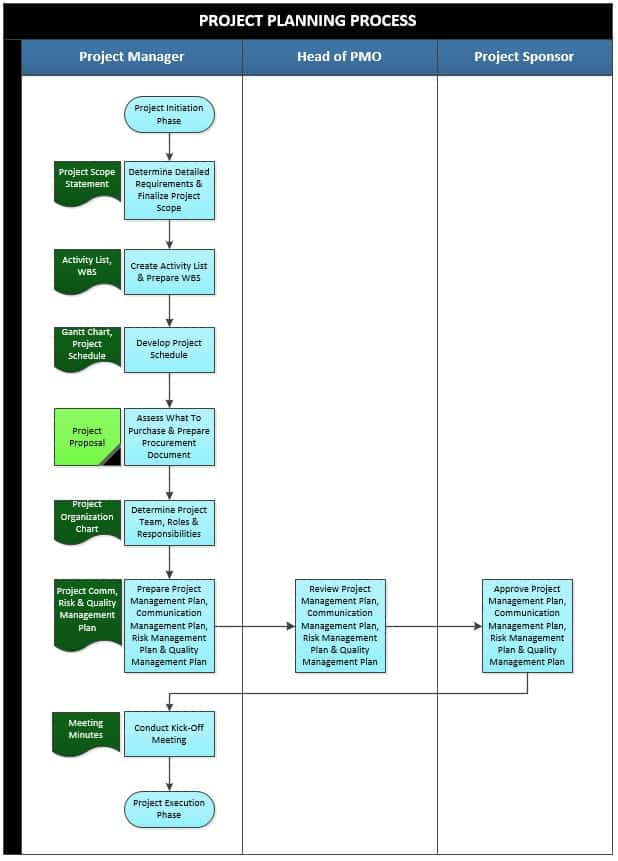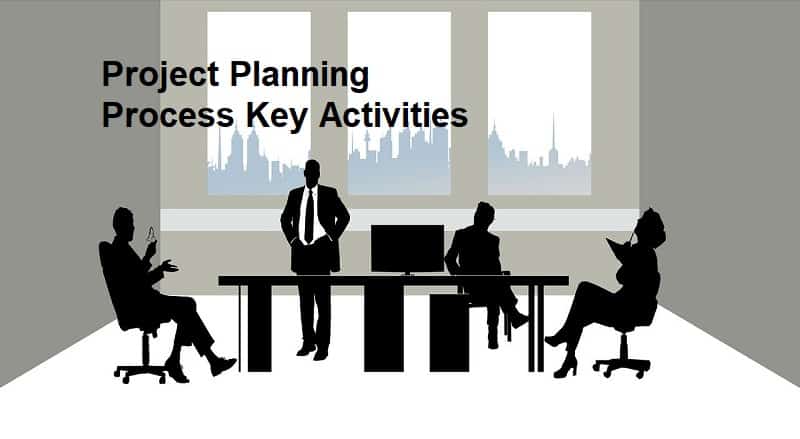The objective of the project planning process is to make plans for project implementation. The project planning process also helps in identifying all the resources required to run the project. This helps in coming up with a budget estimation for the project. It also helps in identifying and sourcing of possible suppliers for various requirements of the project. This therefore results to proper management of time and budgetary resources as there is maximization of available resources. This process is based on the PMBOK framework. This means it is a proven practice that is applied widely in project management.
All options available for every stage of the project are weighed up to determine which works best for the project at hand. This helps the project managers to optimally plan on the time and budget allocated for the project.
The objectives of the project planning process are:
- To identify project requirements – The project managers identify all requirements for the project beforehand. This helps them to source for possible suppliers thus prevents loss of time later on trying to source for suppliers.
- To establish a budget, schedule, milestones and deadlines – The project managers are able to come up with a budget with the project costs estimates. They also lay out a well-defined schedule with all steps to be taken on the project with clear deadlines and milestones.
- To plan on available resources – The project managers are able to come up with plans on all available resources. This helps them to maximize on use of all available resources especially human and budgetary resources.
Thus, the scope of the project planning process covers:
- Scope planning – this specifies all the requirements of the project in order to come up with a work break-down structure (WBS).
- Preparing of the WBS – this spells out the division of the project into specific task and sub-tasks.
- Project schedule development – it lists a timeline of the activities of the project and details an implementation sequence for them.
- Resource planning- it indicates who is to do a specific task, and at what time it should be done, and if there is any specific skills required to tackle it.
- Budget planning – it specifies the cost estimations for the whole project.
- Procurement planning – it focuses on suppliers and contractors involved in the project.
- Risk management – this involves planning on all risks to be possibly encountered in the project implementation and all options available to counter them.
- Quality planning – this assesses a quality standard to be followed in the project.
- Communication planning – this involves coming up with a design of a communication protocol to be used between the parties involved in the project.

The project planning process consists of the following activities.
1. Determine Detailed Requirements and Finalize Project Scope
This activity aims to establish in details all the requirements of the project and also to finalize laying out the scope of the project. The project manager determines what resources are required in each and every step of the project. They also lay out the scope of the project to ensure a smooth flow of events in the project implementation.
In the end of this activity, a Project Scope Statement document is developed. This is the document that details the scope of the project and acts as a guide to ensure that all factors have been considered and are fully covered.
2. Create Activity List and Prepare WBS
The purpose of this activity is to come up with a list of all activities of the project with their timelines, and to also prepare a work break-down structure (WBS) for the project.
The project manager establishes a timeline for all activities involved in the project. The project is also broken into smaller tasks and sub-tasks with well-defined timelines for optimal execution. The output of this activity is two documents: an Activity List and a WBS.
3. Develop Project Schedule
Here, the schedule of the project is developed. This includes establishing what should be done, when it should be done and what resources to be used to optimally carry out the task. The project manager lists all the activities alongside the milestones and their deliverables, all with the intended start date and finish date.
This ensures that a clear timeframe is followed to implement and complete the project. A Gantt Chart and a Project Schedule are the output documents of this activity. A Gantt chart is a type of a timeline chart that lists all activities against their timelines thus showing their estimated start and end dates while a project schedule is a list of all activities, milestones and their deliverables with their estimated timelines.
4. Assess What to Purchase and Prepare Procurement Document
This activity involves evaluating the things that should be bought to facilitate the successful implementation of the project. Doing this helps the project manager to identify all the items that should be purchased and prepare the necessary procurement documents. Besides, the activity helps to come up with cost estimates for the required items.
The project manager therefore comes up with a procurement document that details all the items to be procured including their budget estimates and possible suppliers. To perform this activity effectively, the project manager references the Project Proposal document.
Related Articles:
- Project Initiation Process: 6 Key Activities
- Project Execution Process: 8 Key Activities
- Project Monitoring and Control Process: 10 Key Activities
- Project Closing Process: 8 Key Activities
- Project Handover Process: 11 Key Activities
- Risk Management Process: 11 Key Activities
- Quality Management Process: 9 Key Activities
- Change Control Process: 8 Key Activities
- Issue Management Process: 9 Key Activities
5. Determine Project Team, Roles and Responsibilities
The purpose of this activity is to identify the team that will be involved in performing project tasks and activities. The project manager identifies individuals that can perform various activities. The abilities and qualifications of team members are critical in the process of assigning project roles.
Here, the project manager seeks to identify every project task or activity and match it to the most suited individual. The project manager assigns key roles that require special skills to persons that have the required skills. Each role is therefore assigned with respect to the required skills.
The Project Organization Chart is the output document for this activity. This chart provides an outline the project, the personnel to perform various tasks and their roles and responsibilities.
6. Prepare Project Management Plan, Communication Management Plan, Risk Management Plan and Quality Management Plan
The objective of this activity is to design plans and strategies that will facilitate project management, communication management, risk management, and quality management processes throughout the project lifecycle.
The project management plan is created to keep the project on schedule and within budget. It ensures that the project goals and objectives are satisfactorily met and the resources allocated are optimally utilized.
The communication management plan establishes a protocol to be followed for communication throughout the entire project. This ensures that a proper communication channel is established to prevent a communication breakdown.
The risk management plan assesses all possible risk in every step of the project. This helps the project manager to plan on ways to avoid or mitigate any risk that comes up. This therefore ensures that the project manager and his entire team are well prepared for any underlying risk.
The quality management plan helps to lay down certain quality standards to be followed throughout the project. This ensures that the quality of the project is not compromised at any level.
Thus, Project, Communication, Risk & Quality Management plans are the output documents of this activity. After preparing these plans, the project manager forwards them to the Head of PMO for review. Then, the Head of PMO hands them over to the project sponsor for approval. The approval of these documents permits the project manager to conduct the kick-off meeting.
7. Conduct Kick-off Meeting
The aim of the Conduct Kick-off Meeting is to bring together all the key stakeholders of the project such as the project manager, the project sponsors and project team, in order to debrief them about the project and commence the project execution.
The project manager conducts the kick-off meeting in order to bring on set all the involved personnel and inform them about their roles and responsibilities in the project. The Meeting Minutes are the output of the kick-off meeting. The minutes record the matters that have been discussed and the conclusions that have been made.
Conclusion
The project planning process is very vital because it helps to create and document project plans, requirements, deliverables, and the schedule. Thus, a full understanding of the activities involved in this process will help to lay the perfect foundation for project execution. At the end of the project planning process, all the necessary plans concerning the schedule, resources, and staff needed to complete a project are completed.

